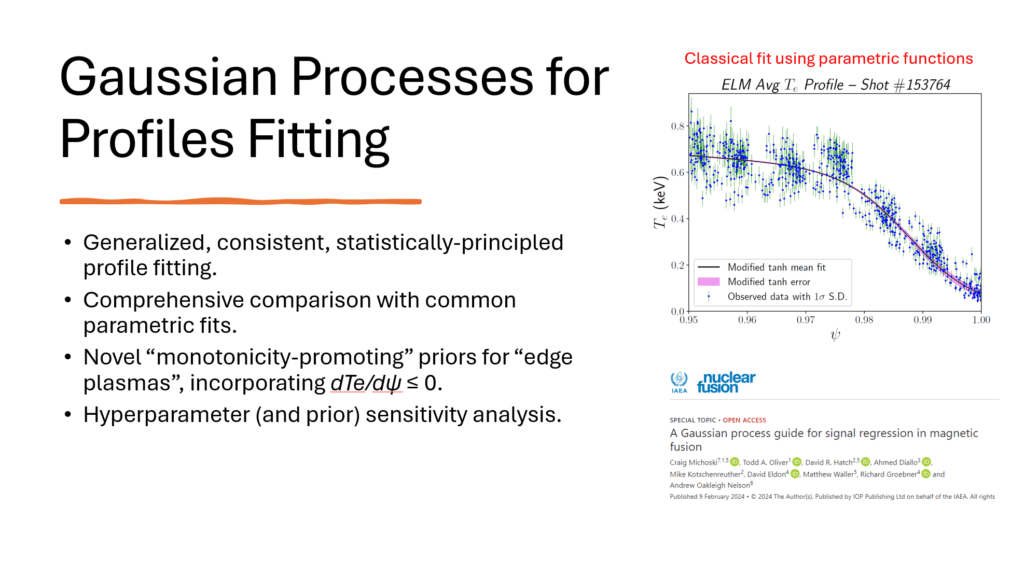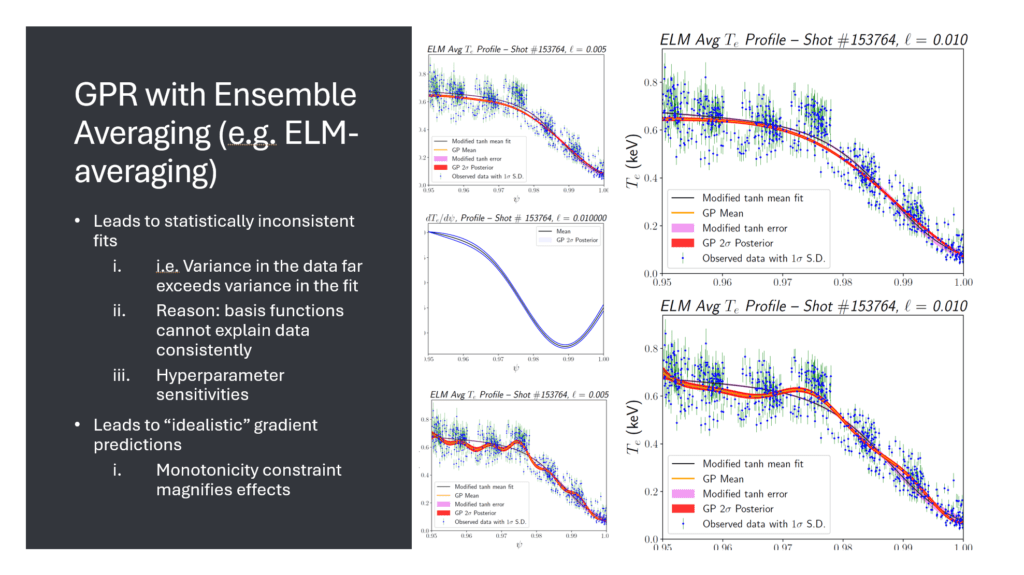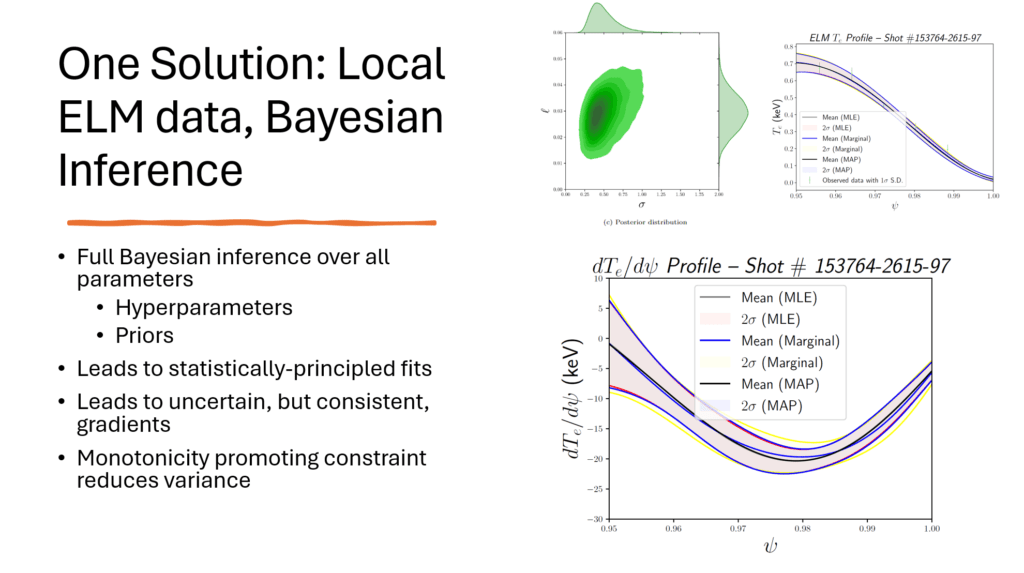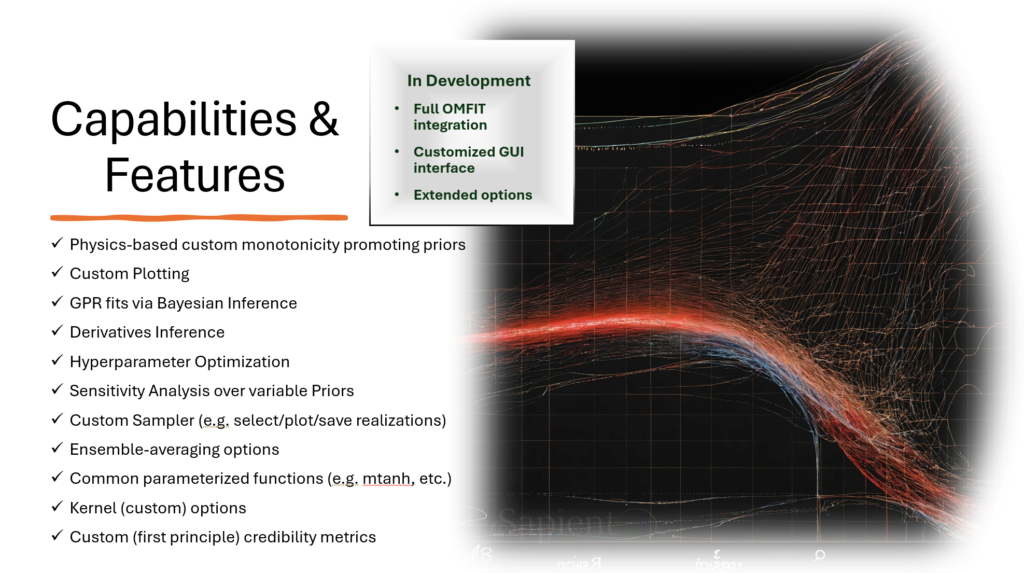Target audience: introductory; some technical background in data science.
Machine learning can help in a variety of ways when trying to generate clean, renewable, sustainable energy from fusion. Fusion energy occurs when two atoms come together to produce a new element, as well as energy.
Today’s experiments in the private and public sector are working on a number of methods to make that energy procurement economical, since fusion fuel is plentiful, fusion produces no direct carbon, and it has implicit safety.
Machine learning techniques can help scientists and engineers find patterns in their experiments’ diagnostics and derive insights about fundamental plasma physics. Or it can assist experimentalists in optimizing over countless combinations of control settings to get the best performing experiments. Whatever the case, fusion experiments can generate troves of valuable data, with conditions so extreme as to occur nowhere else in our solar system, and coupling machine analysis with human expertise is a valuable tool in the path toward bountiful energy.
Recently, we at Sapientai took a close look at a particular technique to understand exactly how a plasma performs under fusion relevant conditions. Given the incredible conditions in fusion machines, it can be a challenge to know how to interpret signals arising from the experiment.
One tool fusion experts are using is Gaussian Process Regression.
You should also Read:
1. Why Fusion Energy: Navigating the Promises and Challenges
2. Low-Rank Adaptation (LoRA) and Quantization Unlocking AI Efficiency
3. Recent Trends in AI: Shaping the Future of Technology

Gaussian Process Regression (GPR)
“Gaussian” refers to a bell-shaped curve that many things in nature follow (i.e. a Gaussian distribution), like how tall people are or how test scores are spread out. “Process” means it’s a method that happens over time or space. “Regression” refers to drawing a line through dots to see the overall trend in data.
A machine learning model uses what it knows about some points to guess what might happen at other points it hasn’t seen yet. For example, knowing the temperature at noon and at 2 PM could lead to a good guess about the temperature at 1 PM. The Gaussian doesn’t just give predictions, however. It also helps measure how uncertain it is about those predictions
This process can go as follows:
- Spatial correlation: The process assumes data points close to one another are likely to have similar values, and all uncertainties in measurements are also tracked. For example, the temperatures (and uncertainties) recorded at different weather stations within a single city are often very similar to each other.
- Prediction mechanism: To estimate an unknown value, the process considers known values in the vicinity. For instance, to predict the temperature at a weather station in a city, it would analyze the measured temperature at nearby stations.
- Uncertainty quantification: Each prediction comes with an uncertainty estimate, which also provides a confidence interval around the predicted value.
- Variable confidence levels: The size of this confidence interval fluctuates based on the available information. Predictions for points near known data points have narrower intervals, indicating higher confidence. And predictions for points far from known data have wider intervals, suggesting lower confidence.
- Gaussian distribution: The uncertainty is modeled using a Gaussian (normal) distribution. This distribution is bell-shaped, with the peak representing the most likely prediction and the width associated with the level of uncertainty, or variability.
- Adaptive learning: As new data is incorporated, the GPR adjusts both its predictions and uncertainty estimates across the entire dataset.
This approach allows the GPR to not only make predictions but also provide a measure of confidence and expected variability for each prediction. This feature is particularly valuable in scientific applications, as it highlights areas where additional data collection might be beneficial and identifies regions where predictions can be considered more reliable.
The Sapientai Paper:
Our paper, titled “A Gaussian process guide for signal regression in magnetic fusion,” explores the application of GPRs in analyzing data from magnetic fusion experiments, particularly focusing on plasma edge electron temperature profiles in tokamaks.
What is a tokamak and what is an electron temperature profile then?
In a tokamak, which is a toroidal (donut shaped) machine used to generate fusion energy, plasma is kept together in the center of the device (that is, inside the hollow tube that makes the circle) and away from the device’s edges. They’re confined using magnetic fields. A plasma is made up of tiny particles called electrons and ions, and ions are charged atoms that have gained or lost electrons. The electrons move around very quickly, and how fast they move tells us how hot they are. This is what we call the electron temperature.
The electron temperature isn’t the same everywhere inside the tokamak. Usually, it’s hottest in the middle and gets cooler as you move towards the edge. This change in temperature from the center to the edge is what can broadly be called the electron temperature profile.
Understanding these temperature profiles help scientists know how well the tokamak is working and how close they are to making fusion energy. By studying these profiles, scientists can learn how to make the plasma hotter and keep it hot for longer, which are key steps in making fusion energy a reality.
In the paper, we go into depth on how GPR can extract reliable information from diagnostic data from the tokamaks. We discuss various aspects of GPR implementation, including hyperparameter selection, prior distribution choices, and model validation. And we address challenges such as dealing with sparse data and the importance of carefully considering prior assumptions.
The Benefits of GPRs
GPRs have a number of benefits.
They have flexible profile fitting: The paper shows that GPR provides a more flexible approach to fitting electron temperature (Te) profiles compared to traditional methods, which allows GPR to capture subtle features in the data that might be missed by more rigid forms.
GPRs also provide uncertainty estimates for the fitted profiles. This is crucial for: a) Identifying regions where the data is more or less reliable and/or variable b) understanding how those uncertainties affect things like temperature gradients, and c) assessing the confidence in any conclusions drawn from the data. GPRs are also versatile in how they can handle both dense and sparse data.
Caution on GPRs
GPRs, powerful though they may be, still require care, understanding, and intuition to be properly used.
Results can be sensitive to prior assumptions and hyperparameter choices. In cases of sparse data, GPR may not be able to distinguish between different possible behaviors without additional information. It’s important to know what one does not know, and to take care not to over-interpret results.
Careful consideration is required when applying GPR to ensure that the results are physically meaningful and not simply, for example, just artifacts of the methodology.
Practical Conclusions
We show that GPRs can highlight areas where additional data collection would be most beneficial, guiding future experimental designs. Furthermore, the method’s ability to quantify uncertainties can inform the development of more precise diagnostics.
GPR’s flexibility allows it to be adapted to various types of fusion data, potentially leading to new insights across different experimental setups. The challenges encountered in applying GPR to fusion data may motivate the development of new statistical techniques tailored to the specific needs of fusion research.
All in all, a GPR can provide more nuanced and potentially more reliable information about plasma profiles and serve as a powerful tool for extracting reliable, nuanced information from fusion diagnostic data. This information can then be used to better understand plasma behavior, test theoretical predictions, and guide future experimental and modeling efforts in fusion research.








